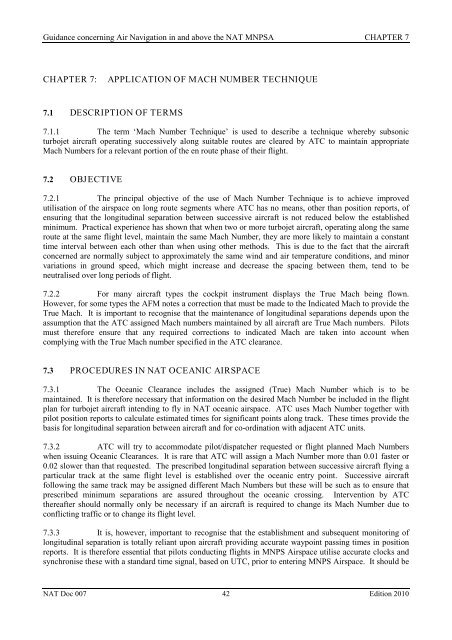World Air Ops | NAT | Doc 007 MNPS Guidance
World Air Ops | NAT | Doc 007 MNPS Guidance
World Air Ops | NAT | Doc 007 MNPS Guidance
You also want an ePaper? Increase the reach of your titles
YUMPU automatically turns print PDFs into web optimized ePapers that Google loves.
<strong>Guidance</strong> concerning <strong>Air</strong> Navigation in and above the <strong>NAT</strong> <strong>MNPS</strong>A CHAPTER 7CHAPTER 7:APPLICATION OF MACH NUMBER TECHNIQUE7.1 DESCRIPTION OF TERMS7.1.1 The term ‘Mach Number Technique’ is used to describe a technique whereby subsonicturbojet aircraft operating successively along suitable routes are cleared by ATC to maintain appropriateMach Numbers for a relevant portion of the en route phase of their flight.7.2 OBJECTIVE7.2.1 The principal objective of the use of Mach Number Technique is to achieve improvedutilisation of the airspace on long route segments where ATC has no means, other than position reports, ofensuring that the longitudinal separation between successive aircraft is not reduced below the establishedminimum. Practical experience has shown that when two or more turbojet aircraft, operating along the sameroute at the same flight level, maintain the same Mach Number, they are more likely to maintain a constanttime interval between each other than when using other methods. This is due to the fact that the aircraftconcerned are normally subject to approximately the same wind and air temperature conditions, and minorvariations in ground speed, which might increase and decrease the spacing between them, tend to beneutralised over long periods of flight.7.2.2 For many aircraft types the cockpit instrument displays the True Mach being flown.However, for some types the AFM notes a correction that must be made to the Indicated Mach to provide theTrue Mach. It is important to recognise that the maintenance of longitudinal separations depends upon theassumption that the ATC assigned Mach numbers maintained by all aircraft are True Mach numbers. Pilotsmust therefore ensure that any required corrections to indicated Mach are taken into account whencomplying with the True Mach number specified in the ATC clearance.7.3 PROCEDURES IN <strong>NAT</strong> OCEANIC AIRSPACE7.3.1 The Oceanic Clearance includes the assigned (True) Mach Number which is to bemaintained. It is therefore necessary that information on the desired Mach Number be included in the flightplan for turbojet aircraft intending to fly in <strong>NAT</strong> oceanic airspace. ATC uses Mach Number together withpilot position reports to calculate estimated times for significant points along track. These times provide thebasis for longitudinal separation between aircraft and for co-ordination with adjacent ATC units.7.3.2 ATC will try to accommodate pilot/dispatcher requested or flight planned Mach Numberswhen issuing Oceanic Clearances. It is rare that ATC will assign a Mach Number more than 0.01 faster or0.02 slower than that requested. The prescribed longitudinal separation between successive aircraft flying aparticular track at the same flight level is established over the oceanic entry point. Successive aircraftfollowing the same track may be assigned different Mach Numbers but these will be such as to ensure thatprescribed minimum separations are assured throughout the oceanic crossing. Intervention by ATCthereafter should normally only be necessary if an aircraft is required to change its Mach Number due toconflicting traffic or to change its flight level.7.3.3 It is, however, important to recognise that the establishment and subsequent monitoring oflongitudinal separation is totally reliant upon aircraft providing accurate waypoint passing times in positionreports. It is therefore essential that pilots conducting flights in <strong>MNPS</strong> <strong>Air</strong>space utilise accurate clocks andsynchronise these with a standard time signal, based on UTC, prior to entering <strong>MNPS</strong> <strong>Air</strong>space. It should be<strong>NAT</strong> <strong>Doc</strong> <strong>007</strong> 42 Edition 2010
















